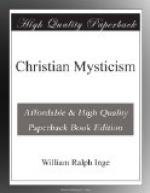[Footnote 220: Berengar objected to the crudely materialistic theories of the real presence which were then prevalent. He protested against the statement that the transmutation of the elements takes place “vere et sensualiter,” and that “portiunculae” of the body of Christ lie upon the altar. “The mouth,” he said, “receives the sacrament, the inner man the true body of Christ.”]
[Footnote 221: Similar teaching from the sacred books of the East is quoted by E. Caird, Evolution of Religion, vol. i. p. 355.]
[Footnote 222: This is the accepted phrase for the work of the twelfth and thirteenth century theologians. We might also say that they modified uncompromising Platonic Realism by Aristotelian science. Cf. Harnack, History of Dogma, vol. vi. p. 43 (English translation): “Under what other auspices could this great structure be erected than under those of that Aristotelian Realism, which was at bottom a dialectic between the Platonic Realism and Nominalism; and which was represented as capable of uniting immanence and transcendence, history and miracle, the immutability of God and mutability, Idealism and Realism, reason and authority.”]
[Footnote 223: The great importance of Bernard in the history of Mysticism does not lie in the speculative side of his teaching, in which he depends almost entirely upon Augustine. His great achievement was to recall devout and loving contemplation to the image of the crucified Christ, and to found that worship of our Saviour as the “Bridegroom of the Soul,” which in the next centuries inspired so much fervid devotion and lyrical sacred poetry. The romantic side of Mysticism, for good and for evil, received its greatest stimulus in Bernard’s Poems and in his Sermons on the Canticles. This subject is dealt with in Appendix E.]
[Footnote 224: Stoeckl says of Hugo that the course of development of mediaeval Mysticism cannot be understood without a knowledge of his writings. Stoeckl’s own account is very full and clear.]
[Footnote 225: The “eye of contemplation” was given us “to see God within ourselves”; this eye has been blinded by sin. The “eye of reason” was given us “to see ourselves”; this has been injured by sin. Only the “eye flesh” remains in its pristine clearness. In things “above reason” we must trust to faith, “quae non adiuvatur ratione ulla, quoniam non capit ea ratio.”]
[Footnote 226: Richard, who is more ecstatic than Hugo, gives the following account of this state: “Per mentis excessum extra semetipsum ductus homo ... lumen non per speculum in aenigmate sed in simplici veritate contemplatur.” In this state “we forget all that is without and all that is within us.” Reason and all other faculties are obscured. What then is our security against delusions? “The transfigured Christ,” he says, “must be accompanied by Moses and Elias”; that is to say, visions must not be believed which conflict with the authority of Scripture.]




